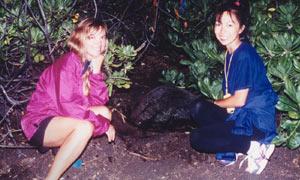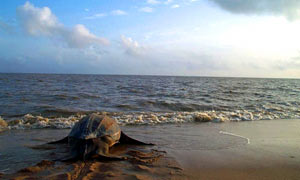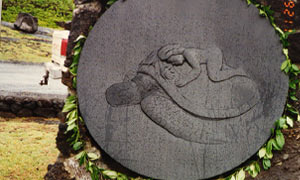Who We Are
The inspiration for the World Turtle Trust began in 1989 when a small group of volunteers formed the "The Honu Project". "Honu" is the Hawaiian word for sea turtle. We somehow came to love and care about sea turtles and wanted to help in some way to save them. After much reflection, we decided to focus on education through producing video documentaries on sea turtle conservation issues. With very limited resources, we successfully completed three documentaries on sea turtles. Red Turtle Rising won the "Hawaii Film and Video Maker" award at the 1999 Hawaii International Film Festival. You can read more about those documentaries below.
 Those years of both successes and struggles as a grass roots organization inspired us to create the World Turtle Trust, an organization that could reach out and help other small projects like The Honu Project all over the world. Through our history of committed, volunteer work on many sea turtle conservation projects, we established our credibility in the sea turtle community and proved that we really did "walk our talk". Our vision of becoming the World Turtle Trust, a global sea turtle link, became a reality in January 2003.
Those years of both successes and struggles as a grass roots organization inspired us to create the World Turtle Trust, an organization that could reach out and help other small projects like The Honu Project all over the world. Through our history of committed, volunteer work on many sea turtle conservation projects, we established our credibility in the sea turtle community and proved that we really did "walk our talk". Our vision of becoming the World Turtle Trust, a global sea turtle link, became a reality in January 2003.
 We know the work has just begun but we are excited about the incredible possibilities ahead. We look forward to becoming team members with caring people like you and dedicated conservation groups working to do their part to help sea turtles all over the planet.
We know the work has just begun but we are excited about the incredible possibilities ahead. We look forward to becoming team members with caring people like you and dedicated conservation groups working to do their part to help sea turtles all over the planet.
The Honu Project, dba the World Turtle Trust is a non-profit, 501(c)3 tax-exempt corporation. Contributions are tax-deductible in the United States to the extent allowed by law.
For All Time Video Documentary
As the parent organization of the World Turtle Trust, The Honu Project has a first-hand understanding that a burning desire, commitment and determination can overcome a lack of experience and money.
The seed for The Honu Project was planted in the summer of 1990 when two of us decided to take a brief trip to Costa Rica. There were early signs that this would be an unusual journey. In the capital city of San Jose, a car rental agent insisted on reading our tarot cards. As we backed out of his driveway, he chased after us holding two sticks of incense . "Take these," he said. "Burn them somewhere along your journey and make a wish."
We zipped out of the city in our little rental car, and headed west to a bed and breakfast at Playa Hermosa on the Pacific coast. We drove for miles along the Interamerican Highway until we reached the dusty town of Liberia where we stopped to ask directions. Neither of us spoke Spanish, so we were relieved when a young man, Michael, spoke to us in broken English. Michael and his friend Juan offered to guide us to Playa Hermosa in their Jeep.
Playa Hermosa was a beach front tropical paradise. Dinner and a few cocktails helped us overcome our language barriers. Juan drew pictures of turtles and the words Playa Grande on a cocktail napkin giving us the impression that we could see turtles on the beach.
It was late, but we insisted we wanted to see the giant turtles. Traveling over washed out dirt roads, we reached "Playa Grande" just before daybreak. As dawn broke, we saw acres of pristine beach littered with slender white shells. But there were no turtles. Juan continued his pantomime until we understood that we needed to return to this spot in six months. November was the turtle nesting season.
Micahel and Juan left, but the idea of seeing giant turtles stayed with us. Back at Playa Hermosa, we drew pictures of turtles and asked every local person who would listen if they had ever seen a giant "tortuga." Those who had, stretched out their arms to indicate the turtle's enormous size.
It was time to leave Playa Hermosa, but first, we satisfied our urge to see Playa Grande once more. It's a wonder that we ever found the place again. The rental car seemed to navigate for us. Somehow, it rattled down the same washed-out dirt roads, passing pigs and roosters, and stopped when we reached Playa Grande. We walked the length of the beach and took in its vastness, secretly still hoping to see giant turtles. The beach was pristine, except for one small structure where a man and young boy stood by their Jeep.
On our last night in Costa Rica we saw dog-sized iguanas rustling in the jungle at the entrance to Manuel Antonio National Park. There, we lit the incense sticks the car rental agent had given us and declared our love for the country. We made a wish that we could do something to help it.
While we waited in the airport for our flight home a middle-aged man introduced himself. He was an owner of the small structure we'd seen on the beach, and he boasted of his plans to turn it into a fifty-five unit hotel with a turtle-shaped swimming pool. "What about the turtles?" we asked, "My hotel will give visitors a good opportunity to see them," he answered.
Back home in Hawaii, a question gnawed at us, 'could turtles and development coexist'? We needed to learn more. We attended a lecture about turtles. The speaker was a world renowned sea turtle expert, George Balazs, a marine biologist with the National Marine Fisheries Service in Honolulu. We spoke to Mr.Balazs about our Costa Rica experience. He did not know about the planned development, but he gave us the information we needed to spring into action. Playa Grande was one of the world's most important nesting sites for the endangered leatherback turtle.
We were astounded. At the local library, we did some perfunctory research. A photo of a leatherback, the size of a Volkswagen Beetle captured our imagination. This was a creature of superlatives . It took a split second for us to appreciate its distinctive jack-o-lantern smile--then we adored it.
George Balazs thought we should share what we had heard about the Playa Grande development plans with a long list of his biologist colleagues. We wrote letters to all of them on "The Honu Foundation" letterhead. "Honu" is the Hawaiian word for sea turtle. Soon, we received a phone call from Dr. Peter Pritchard, the Official Sea Turtle Advisor to the government of Costa Rica. He said we had a common goal. Costa Rica wanted to buy out the private landowners at Playa Grande and make a national park to protect the leatherback turtles that nested there.
We apologetically explained to Dr. Pritchard that we had no money but wanted to help. After the phone call, we changed our letterhead to "The Honu Project." We pondered what we could do to contribute to the cause and decided to produce a documentary about Playa Grande, its turtles and the threat posed by coastal development. Having no experience, we enrolled in local community college and adult education video production classes.
To gain some credibility we also volunteered at Earthtrust, a Hawaii-based international wildlife conservation organization. Eventually, we obtained a letter of support from the Program Director. He also gave us permission to raise money using Earthtrust's tax-exempt status. We were in business!
We contacted Dr. Pritchard, and he agreed that a video would bolster his fundraising efforts. We made an inquiry with the Costa Rican government, and to our amazement, we received a fax inviting us to make the "Official Foreign Student Video" to support the creation of "Las Baulas de Guanacaste National Park" at Playa Grande. As it was already turtle nesting season, the letter suggested that we begin filming the following month.
We had no crew, so Roz secured the help of one of her travel agency clients, Sean Hayes. Sean was a professional videographer who liked adventure travel. He and his soundman, Rick Nyren, agreed to volunteer their time for the upcoming video shoot in Costa Rica. They also found a director.
Armed with letters from Earthtrust, the Costa Rican government, and new endorsements from George Balazs and Peter Pritchard, we borrowed professional video equipment from a local production company. Our video school instructors offered advice up to the last minute. In late December 1990, our volunteer video crew and The Honu Project flew to Costa Rica. Our personal charge cards covered the team's airfare and enabled us to pay for food and accommodations when our limited cash ran out. We were filled with emotions about leading our first video expedition, working with the Costa Rican government, and the prospect of seeing a leatherback turtle for the first time.
For a week, we shot footage in Playa Grande and the surrounding area. We met Rosa, the local nest counter, as she walked the beach with her donkey. She clicked a mechanical counter every time she saw a new turtle nest. We filmed the Boy Scouts who patrolled the beach protecting the nests from poachers. Local residents and landowners shared their thoughts about the turtles and development. Maria Teresa Koberg, Costa Rica's Director of the Sea Turtle Rescue Program, and her boss, Mario Boza, the country's Vice Minister of Energy, Resources and Mines contributed their insights. Dr. Pritchard provided narrative about the importance of the turtles and the national park. He also took us to some beautiful estuaries surrounding Playa Grande that were to be included in the park's boundaries.
The greatest magic was spending several nights on the beach with the giant leatherback turtles. We waited in the dark and kept the lights on our equipment off, as lights could deter the females from emerging from the ocean. We took turns walking the beach looking for turtles. Our eyes and anticipation fooled us. and We spent fifteen minutes at a time watching what turned out to be rocks. After many hours, patience was rewarded when we saw the first giant mother hauling herself up the beach toward the mangrove, gasping and groaning. When she found the right site, she began spinning her powerful flippers kicking up a dust storm of sand. With her rear flippers, she sculpted a perfect pit. Then, in what seemed to be a trance-like state, she laid her eggs. More and more turtles emerged as others returned to the sea. The last one left at dawn. In the soft light, we captured her on film.

Matthew Godfrey
Back in Honolulu, a crash editing session began. In a make-shift home studio, a volunteer editor worked feverishly for two weeks. Earthtrust's professional video editor joined in for final editing. Narada Productions donated the musical rights. A Honolulu artist created a beautiful color video jacket. We entitled our video For All Time to capture Dr. Pritchard's expression of the importance of creating a national park for the leatherback turtles and hatchlings of Playa Grande, 'for all time.'
See For All Time on youtube here
Dr. Pritchard presented For All Time in February 1991 at the International Sea Turtle Biology and Conservation Workshop in North Carolina. He, the Costa Rican government, and others used the video to support their joint efforts to raise money to buy out private landowners and create the national park. George Balazs was steadfast in his encouragement and support throughout the project. In May 1991, The Honu Project received a Certificate of Merit from the Marine Turtle Specialist Group of the International Union for the Conservation of Nature. In 1992, For All Time received a Bronze Award at the Houston International Film Festival. The same year, the Costa Rican government created "Las Balaus de Guanacaste National Park" at Playa Grande.
Fall Of The Ancients Video Documentary explores deadly turtle tumors
After we completed our international project in Costa Rica, The Honu Project began thinking about what it could do to help sea turtles in Hawaii. We contacted George Balazs, a Hawaii-based sea turtle expert. He alerted us to a mysterious disease called fibropapilloma (FP) that afflicts sea turtles. FP was originally associated with green sea turtles, but had begun to appear in other species. In some areas, it was reaching epidemic levels. We accompanied Balazs on his research expeditions and watched him work. With a team of helpers, he measured, weighed, and tagged the animals. Then he carefully examined each one for FP tumors. The moment we saw turtles afflicted with this hideous disease, we knew that FP would be the focus of our next video project. The disease appeared as frightening, cauliflower-looking tumors. Turtles had tumors on their eyes, neck and other soft parts of their bodies. Balazs explained to us that the tumors could also grow inside turtle's gullets. These growths threaten sea turtles' ability to see, breathe, and eat. Ultimately, FP can be fatal. In this documentary we also addressed other threats to sea turtle populations, including poaching and environmental pollution. We called the video Fall of the Ancients because we came to realize that although sea turtles have been swimming in the oceans since the time of dinosaurs, their continued existence is in serious jeopardy. For more information on fibropapilloma, we recommend a site called Turtle Trax at www.turtles.org , and the book, Fire in the Turtle House.
He La Honu - Turtle Day 1995
Punalu'u celebrates the "Year of the Sea Turtle"
In 1995, during a year-long campaign for endangered sea turtle conservation and habitat protection programs, the Hawaii State Legislature joined many Pacific nations and territories in declaring 1995 the "Year of the Sea Turtle." To celebrate this special year, The Honu Project donated a monument at Punalu'u Beach Park on the Big Island of Hawaii in honor of Hawaiian sea turtles and the "Legend of Kauila" . The monument overlooks scenic Punalu'u Bay which teams with green sea turtles, and is also an important site for sea turtle researchers.

The 4-foot lava rock monument features a striking cast bronze disc that depicts "Kauila," a mystical turtle who would turn into a young girl so she could play with the children in the bay and watch over them. The monument was designed by Hawaii artist and Honu Project board member, Dale Zarrella, and made possible by the generosity of the Gummow Family. Scores of residents from the nearby community of Ka'u volunteered their time and energy to assist Zarrella in building the lava rock base. The monument was completed with the cooperation and effort of the community of Ka'u, volunteers from the University of Hawaii at Hilo Marine Options Program, the County of Hawaii, the National Marine Fisheries Service, and The Honu Project.
On November 25, 1995, over 300 turtle lovers gathered at Punalu'u Beach Park to celebrate the monument's unveiling and the Year of the Sea Turtle. This was followed by a wonderful community celebration including hikes, entertainment, Hawaiian crafts and food.
The Punalu'u Monument Project is particularly important to us because the children of Ka'u participated in its development, learning precious lessons about sea turtle conservation and protection that can be handed down to future generations.
Red Turtle Rising Video Documentary-Hawaii International Film Festival Award
Red Turtle Rising began as a Honu Project documentary about an inspiring hawksbill monitoring program at Kamehame Beach on the island of Hawaii. The program was created by Larry Katahira of Hawaii Volcanoes National Park on the island of Hawaii. Larry's volunteers come from across the country. They camp out on the beach for weeks at a time. At night they watch for female nesting turtles and the emergence of hatchlings. The Honu Project spent several days and nights shooting footage with Larry and the volunteers, and turtle magic took over. Director Jay April and cameraman Lou Di Liberto joined in the project, and contributed extraordinary vision to create an amazing documentary that weaves together the legend of the ancient Hawaiian turtle goddess Kauila with the real life saga of the mysterious and severely endangered hawksbill turtle. Internationally acclaimed Hawaiian recording artist Keali'i Reichel visited the set and made a guest appearance. Red Turtle Rising captures stories in chant and hula that have not been told in centuries, and the work of biologists who seek to protect a being whose ancestors saw the rise and fall of the dinosaurs. This documentary was funded in part by the U.S. Fish and Wildlife Service. It received the Hawaii Filmmaker and Video Award at the Hawaii International Film Festival. For ordering information, please visit our Gift Shop .

